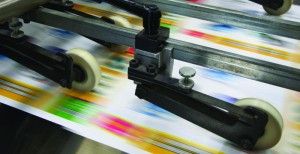Printing Careers Background
 Printing is a dynamic and highly technical industry that enters into nearly every facet of our lives. Practically every product you buy, use, or look at involves some sort of printing: a sign in a store window, your favorite magazine, a soda can or cereal box, the instructions to the latest computer game you bought, a billboard on the roadside, even this encyclopedia you are reading.
Printing is a dynamic and highly technical industry that enters into nearly every facet of our lives. Practically every product you buy, use, or look at involves some sort of printing: a sign in a store window, your favorite magazine, a soda can or cereal box, the instructions to the latest computer game you bought, a billboard on the roadside, even this encyclopedia you are reading.
In short, printing is a way of communicating. In fact, it is one of the oldest and most important means of recording and transmitting words and ideas.
The concept of printing originated in China. That’s where paper was invented by Ts’ai Lun in AD 105 and where the first known book was printed in 868 using wood blocks and ink. The earliest reported form of movable type (made of clay) was also developed in China: by Pi Sheng in 1045. But because of the complexity of the Chinese language, printing was laborious and did not gain much ground until it caught on in Europe in the late 1300s.
At first, the Europeans used block printing primarily to create artistic and religious illustrations. Then, in the 1440s, Johannes Gutenberg revolutionized the printing process by inventing movable type in metal in conjunction with a wooden printing press. Metal type had several advantages over wood: It was more durable, it allowed identical pieces of type to be cast, and it could be arranged more freely. This quick and inexpensive method of printing led to a flourishing of print shops all over Europe.
In the late 1700s, a young German named Aloys Senefelder developed a new printing process called lithography. He discovered that if he wrote on limestone with a grease pencil, dampened it with water, and then applied ink, the oily ink adhered only to the penciled marks, so that when he pressed paper against the stone it transferred the image. He also learned that the image could be transferred to other stones so that several identical copies could be printed from the same pattern on a single large sheet of paper. Over the next century, thin flexible metal sheets replaced limestone, and lithography eventually became a standard method of printing.
Innovations of the 19th century include the rotary press, which used revolving cylinders to make an inked impression on paper, and the Linotype and the Monotype machines, which automated the process of setting type.
Another revolution occurred in 1905 when American Ira Rubel inadvertently discovered offset printing. He noticed that an image accidentally transferred from the image plate cylinder of his rotary press to the rubber that cushioned the impression cylinder left a much sharper image on paper than the plate itself.
Offset printing, using the process of lithography, is the predominant method of printing today, accounting for more than half of all printing done in the United States. Of course, the process has been honed, but the principle is the same: A series of cylinders are used to transfer ink from a chemically treated plate onto a rubber cylinder (called a blanket), then onto the paper. The printing plate never touches the paper but is offset by the rubber blanket.
Electronic typesetting was introduced in the 1960s. This process allowed type to be created on a computer system and output to a phototypesetting machine (so called because images were burned onto photographic paper and developed like film). Electronic typesetting replaced the hot type of molten lead and was dubbed cold type. This method, novel for its time, has been on the decline since the 1980s when personal computers and desktop publishing came onto the scene. These new systems allowed users to typeset and design entire pages on their computer screens. Most materials are now produced this way.
Technological advances continue to develop at record speed. Nearly everyone in the printing field today is affected by these new technologies and must be able to adapt and learn quickly to keep pace.